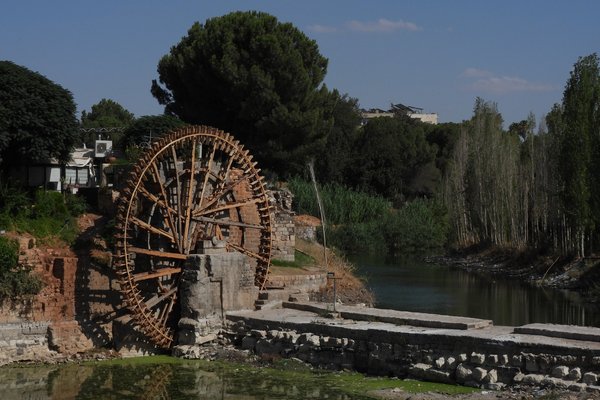Syria
Noréas de Hama
The Norias of Hama are hydropowered wooden wheels to lift water from the river Orontes into an aqueduct for further distribution.
Seventeen of them remain, dating from the 13th-14th centuries. They were used for irrigation but now mostly serve an aesthetic purpose.
Site Info
Official Information
- Full Name
- Noréas de Hama (ID: 1291)
- Country
- Syria
- Status
-
On tentative list 1999
Site history
History of Noréas de Hama
- 1999: Added to Tentative List
- Added to tentative list
- Type
- Cultural
- Criteria
Links
- UNESCO
- whc.unesco.org
All Links
UNESCO.org
- whc.unesco.org — whc.unesco.org
Community Information
- Community Category
- Secular structure: Civic and Public Works
Travel Information
Recent Connections
News
No news.
Community Reviews
Show full reviews
The waterwheels of Hama are one of the most iconic images of Syria. With their history of lifting water and supplying it into aqueducts to be used for irrigation since the Middle Ages, they should be a shoo-in whenever they get nominated, as every WHC loves a bit of water management. In addition to the technology, there's a whole traditional system of skilled noria carpenters behind it as well.
On the ground, however, they are disappointing. At least when you visit out of season, as I did: the wheels only turn in winter and spring, as only then is there enough water. The Orontes River in September was almost empty, except for the heaps of plastic trash that are unfortunately so common in Syria. It is also hard to see the large wooden wheels up close or to get to good viewpoints to take pictures. The best point in the city center is from the bridge.
We saw five of them in the city center; the other twelve or so remaining ones are scattered around the countryside near Hama. According to my guide, they are more impressive as they have a finer natural setting.
Hama itself has preserved its small historical urban zone quite well (at least that part that was left after the 1982 anti-Assad uprising, which was brutally ended), and you can follow the trajectory of the aqueducts. All but one of the waterwheels have survived the war (one was burned deliberately in 2014), but they suffer from …
Keep reading 0 comments
In March 2020 I visited Hama on the way to Aleppo, there are seventeen Wheels in Hama, I was able to visit the most central ones in the main squarethe Norias are centuries old and have survived many wars including the last one. They are admirable to see, the people of Hama go to spend time and have picnics and smoke Sisha around them. If UNESCO inscribed the Hama Waterwheels, they would have greater conservation and protection.
Keep reading 0 comments
In May 2009, the Baron Hotel in Aleppo organized a car and driver to take me and another guest on a day tour to visit Serjilla and Al-Bara, two of the Dead Cities, and Apamea. Since the other guest was continuing to Hama, we visited a few of the remaining 17 original norias (water wheels) before I returned to Aleppo.
The norias move water from a lower to a higher elevation and do not provide mechanical power to any other process, unlike the water wheels at mills.
Keep reading 0 comments

